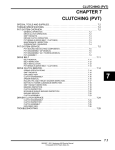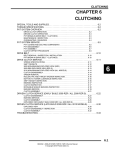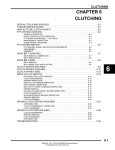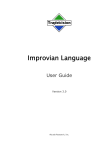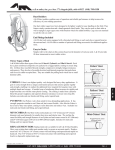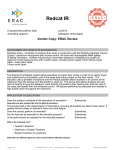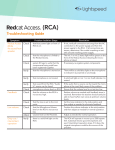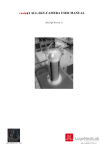Download REDCAT F/A-18C Owner`s manual
Transcript
REDCAT KMX-50 MANUAL REDCAT KMX-50 Congratulations on Purchasing… One of the best all-around children’s quad’s in the world! Besides being one of the most powerful, it has loads of unique features, making the Redcat 50 one of the easiest to ride, most exciting quad’s ever. 1. The engine is a four-stroke for reliability, ease of starting and easy maintenance. 2. The Redcat 50 has a headlight and safety features for the early rider. 3. The quad has its own safety keys —just like Dad’s. (Keys can be locked away as an added safety feature.) 4. The Redcat 50 has a self-starter, so a child can start it himself. 5. One brake stops this little quad —no confusion for the little ones! 6. A governor on the handlebar can be set to allow the Redcat 50 to travel only very slowly for beginners. 7. To ensure a child’s safety, a parent can walk behind the Redcat 50 holding a cord attached to the cutout located at the back of the quad. A quick tug on the cord and the quad will cutout and stop. 8. Its uniquely small size and light-weight make the Redcat 50 easy for a child to handle and easy to load into the family car. 9. Bouncy tires, rear suspension and various gear options with a strong engine will ensure that this little bike can go anywhere. 10. The Redcat 50’s low cost, sturdy design and aggressive looks make it an instant hit with children. The automatic and semi-automatic gear options —both on the same bike —ensure that the Redcat 50 will always excite your riders as they progress from beginner to expert, from tiny tot to confident youth. SAFETY INFORMATION: Safety is extremely important when allowing young children to ride. Children of the same age can have different levels of skill and coordination, so only a parent can understand their child’s capabilities. If a parent decides to allow a child to ride a motorized vehicle, it is essential that they realize that the child’s safety rests entirely in their hands. The child must NEVER be unsupervised. The quad’s power and speed must be set to match the child’s capability at all times. The parent is the only person responsible for the child’s safety. By allowing the child to ride a quad, the parent accepts that this is his sole responsibility and risk. The governor on the quad should be set to allow the child to travel only at a walking pace while learning to ride. The area in which the child is allowed to ride must be free of obstacles that could be a danger to the child and free of people and animals that could be injured. As the child’s capability increases, the quad’s speed can gradually be increased but always only to a safe level. The Redcat 50 is unique in that its gearbox can be locked into first gear for beginners, thereby driving like an automatic vehicle. When the child has more experience, the gearbox can then be locked into second gear by replacing the gear lever and moving it into second gear, then removing the lever again. This way the quad will again function like an automatic vehicle. For older and more experienced children, the gear lever can be left on, giving the quad four semi-automatic gears. This unique design will take the child from beginner to expert, at which time she/he graduates to the next size quad. Please read and apply all the safety information in this manual and on the quad. This quad is designed for off-road use only. ATTENTION: The Safety Alert Symbol means ATTENTION! BE ALERT! YOUR SAFETY IS INVOLVED! WARNING: Failure to follow WARNING instructions could result in severe injury or death to the vehicle operator, a bystander or a person inspecting or repairing the vehicle. CAUTION: A CAUTION indicates special precautions that must be taken to avoid damage to the vehicle. NOTE: A NOTE provides key information to make procedures easier or clearer. • • Failure to follow the warnings in this manual can result in serious injury or death. WARNING —Safety First —Important Notice. Remember: you are responsible for your own safety and the safety of those in your care. Redcat Motors or Lowprice.com cannot be held liable for accidents, no matter what the cause. You are responsible for checking your vehicle thoroughly for faults and for riding safely. Operating any motorized vehicle carries an element of risk. By choosing to ride this vehicle, you have accepted this risk. Redcat and Lowprice.com is not responsible for negligence, speeding, component failure, inexperience or other unforeseen circumstances that can cause injury or death. Remember: Safety First! To help you ride and operate the quad safely, here is some advice you should heed. Only you can protect yourself. Your safety and the safety of minors in your care is your responsibility. 1. Pay attention to and obey the warning labels on the vehicle. If they become faded or are removed, replace them immediately. 2. Take instruction and make certain you are fully aware of – and able to operate – the vehicle’s controls. 3. Ride under the instruction of a competent teacher until you are an experienced rider. 4. These vehicles are designed and manufactured for off-road use only. It is illegal and unsafe to use this machine on any public street, road or highway, tarred, dirt, paved or cement. 5. Check local riding laws and regulations before operating this machine. 6. Check local environmental laws and respect them. Redcat urges you to keep the environment clean, safe and beautiful for all to enjoy, including yourself. 7. Riding an ATV is serious; it can be hazardous to operate. A collision or rollover can occur quickly, often with serious consequences. Even in routine maneuvers such as turning, riding over obstacles and on sloping ground or across water, mud or loose surfaces, the quad handles differently from other vehicles. 8. Never carry passengers, as this alters the handling characteristics dangerously. 9. Never operate the ATV on paved, tarred or cement surfaces. 10. Never exceed the recommended load capacity. Cargo should be properly distributed and securely attached. If carrying a load, allow greater distances for braking and reduce your speed, especially if pulling a small trailer. Overloading or improper loading can cause mechanical failure, loss of control and unnecessary danger. 11. Always keep both hands and both feet securely on the ATV. 12. Never attach unauthorized accessories to the ATV. 13. Never attempt stunts, jumps, wheelies or other tricks. 14. Never ride faster than your skill or conditions permit. 15. Never ride when tired or after consuming alcohol or drugs or while experiencing any dangerous medical condition. 16. Inspect your ATV each time you use it to make sure there are no mechanical faults or problems with tires, brakes or controls. Your ATV must be in safe operating condition at all times, with sufficient oil, gas, and brake fluid and tire pressure. 17. Always follow inspection and maintenance procedures as recommended. 18. Never use your ATV in flowing water or in water deeper than 5 inches. 19. Always use the recommended tires and pressures to reduce the risk of tire failure. 20. Always turn the engine OFF when refueling. 21. Don’t run the engine in an enclosed area —THIS CAN BE FATAL. 22. Always wear an approved helmet that fits snugly as well as eye protection, gloves, a longsleeved jacket and long pants. 23. Engine oil from a recently run motor can be very hot. When draining oil for an oil change, be careful. 24. Be sure to replace fuses with ONLY the correct ones; using an incorrect fuse can cause a fire. 25. When checking battery fluid, remember that a spark could cause the battery to explode. Switch the engine and power OFF and avoid sparks. 26. Never put your feet on the ground when the vehicle is starting off or moving. 27. It is your responsibility to ensure that the ATV is properly and safely ridden and maintained. 28. People should not operate an ATV beyond their physical or mental limits or capabilities. 29. Keep the Owner’s Manual in a safe place on the vehicle or under the seat at all times. 30. While you are learning to ride, use an ATV only on level, open ground away from people. 31. Obey government laws at all times. 32. Contact your dealer about anything related to the ATV that you do not understand or need advice about. 33. If you allow an untrained person to use the ATV, you are endangering his/her life and the lives of others. 34. Check that the ATV throttle, accelerator and cables are free and working. A jammed throttle can cause an expensive and injurious accident. 35. REDCAT cannot be held responsible for your lack of knowledge. If you don’t know, ask your dealer. You ride at your own risk. 36. In some countries ATVs with 50cc or smaller engines cannot be driven by those aged 6 and under. 37. Riders under age 16 should ride only with adult supervision and only after training. 38. All riders should take a course of safety instruction. 39. Never use gasoline (petrol) to clean the ATV. 40. A slight spark could cause a fatal explosion. Keep a fire extinguisher nearby when working on the ATV. 41. Excessive “play” or slippage on a chain drive can cause the chain to break which could, in turn, cause a serious accident. 42. “Grabbing,” shuddering or lack of braking ability could mean there is a serious brake problem. This must be fixed before riding or serious injury could result. 43. The high-tension wire from the CDI unit to the sparkplug generates extremely high voltage and can cause a serious or fatal shock if touched with the power on. 44. Don’t touch any part of the engine, exhaust or silencer until it has cooled down. 45. Don’t siphon toxic liquids such as fuel or brake fluid by mouth or allow them to remain on your skin. 46. Wipe up IMMEDIATELY any oil or grease that could cause you to slip or lose control of the ATV. 47. Don’t allow animals or children to be around an unattended ATV. 48. Keep loose clothing and long hair well out of the way of moving parts. 49. Remember: MANY PEOPLE HAVE LOST FINGERS OR LIMBS that were pulled into moving parts, especially chains. DO NOT WORK ON THE ATV WITH THE ENGINE RUNNING. 50. If, despite following all these precautions, you are injured, seek medical attention immediately. *This list of safety precautions was compiled by Redcat to increase your safety awareness and to improve your safe enjoyment of your ATV. WHEN SAFETY COMES FIRST, ATV RIDING IS FUN, FUN, FUN! TEACHING TECHNIQUES: *This advice especially relates to children on smaller ATVs but applies equally to beginners of all ages. *Instructing the rider. *Important advice to parents, teachers or instructors. Your student’s safety depends on your commitment to take the time necessary to fully educate him/her on the proper operation of the ATV. Remember that proper instruction before your student begins to ride is just as important as proper instruction and supervision while riding. Please go through this manual with your student page by page. Fully explain all of the instructions, requirements and warnings it contains. Be sure to put as much emphasis on safety precautions as on proper operational techniques. Question your student as you go through the manual to ensure s/he understands what you are saying. Following is a step-by-step guide to help make your student’s first use of the ATV safe and enjoyable. Before you begin to use this guide, however, be sure you have reviewed the vehicle features and riding techniques described in the earlier parts of the manual. REDCAT strongly urges that you use this guide to teach each student whom you let ride the ATV. Be sure to take breaks as the student becomes tired or his/her attention starts to wander. Full attention at all times is needed to safely operate any motorized vehicle, including this ATV. STEP 1: PROPER CLOTHING & PROTECTIVE GEAR The first step to safe riding is proper protection of the rider. Your student should always wear a helmet, eye protection, gloves, long pants, a long-sleeved shirt or jacket and boots. Make sure your student is not wearing any loose-fitting clothes. Loose belts, scarves, etc., can get caught in moving parts and cause personal injury. Even in hot weather, make sure the student wears long pants and a long-sleeved shirt. These not only protect against abrasive injuries but also help reduce fatigue which comes from loss of body heat caused by exposure to the wind. STEP 2: FAMILIARIZATION WITH THE VEHICLE Your student should become completely familiar with the names and functions of all controls. Demonstrate operation of the controls if necessary. Ask the student to do such things as “Apply the brakes. Turn off the engine,” etc. Practice this exercise until the student can operate all of the controls without hesitation and without looking at the controls. Review the instructions with your student until she/he knows all the items that should be checked. Give specific examples of things to look for. STEP 3: STARTING OFF AND STOPPING To help your student develop confidence, she/he should PRACTICE FIRST WITH THE ENGINE OFF, as follows: 1. Have student sit on ATV. 2. Instruct student to keep his/her eyes straight ahead while you slowly push the vehicle from behind. This will give the student the “feel” of riding a moving vehicle. 3. As you push the ATV, instruct your student to steer straight ahead and perform operations such as stopping the vehicle and turning OFF the engine switch while moving. Watch your student closely to make sure she/he is operating the controls correctly and without looking at them. 4. As you approach the end of the practice area, tell your student to stop the vehicle. You should drag the rear end of the ATV around so you can push it straight ahead in the opposite direction. 5. Practice with the engine OFF until your student gets the “feel” of using the brakes and can stop the vehicle and turn OFF the engine switch without hesitation and without looking at the controls. STEP 4: ADJUST THE SPEED LIMITER TO SLOW NOW. Next start the ATV’s engine and have the student practice starting off, riding in a straight line and stopping with the vehicle under power. Walk alongside the ATV and hold the engine cutout switch cord or have the student ride back and forth between you and another supervising adult. Make sure your student: 1. Opens the throttle gently when starting off. 2. Releases the throttle and applies the brakes in sequence when stopping. 3. Becomes aware of the distance it takes the vehicle to stop when the engine switch is turned OFF while the vehicle is moving. As you approach the end of the practice session, you should again tell the rider to stop the vehicle and get off so you can turn it around for him/her. Practice this exercise until your student can start off, accelerate, cruise and stop correctly and confidently. STEP 5: TURNING: After your student has learned to ride the ATV in a straight line and can stop it at will, you should teach the student how to turn the vehicle. Explain the proper body movements for turning and let the student PRACTICE FIRST WITH THE ENGINE OFF as you push the vehicle from behind. When turning, watch to make sure your student: 1. Shifts his/her weight slightly forward and supports his/her weight on the outer footrest. 2. Leans his/her upper body into the direction of the turn, pressing down with the opposite leg. When the rider is able to properly turn the ATV in both directions with the engine OFF, she/he should practice turning with the vehicle under power. Again, make sure that the throttle limiter is adjusted to provide a low maximum speed capability. Watch closely to make sure the rider is using the proper technique. The rider should practice turning until s/he can do so correctly and confidently. STEP 6: PUTTING IT ALL TOGETHER When your student has mastered the basic riding maneuvers in the previously listed steps, she/he should practice them all together. Instruct the student to perform various maneuvers such as turning right, turning left, stopping, etc. Vary the order of these maneuvers so the student will not anticipate what s/he will be asked to do next. Practice this exercise until you are confident that the rider has mastered all the basic maneuvers. Using this procedure will help the first-time rider learn the most basic riding techniques. To become a skilled rider, your student will need a great deal of practice and continuing instruction in addition to completing these introductory steps. After all the riding techniques have been mastered, you can adjust the throttle limiter to provide higher speed capabilities in keeping with the rider’s skill and experience. Starting your ATV for the first time: Fuel Valve Adjustment: Make sure to turn the fuel shut off valve to the off position and place a small amount ( a quart or so) of fuel in the gas tank. Then slowly turn the fuel valve to the on position and check for any fuel leaks if you should see any fuel leaking then turn the valve to the off position and fix any fuel leaks before going any farther. Do not try to start the engine at this time. Engine Oil Level: Next check the engine oil level and if its not full then fill to the proper level. It is recommended that with the centrifugal clutch not to use Oil fill plug synthetic oil or a synthetic blend as it is to slick, and could cause premature failure of the clutch lining. In the summer or in hot climate you should use a 15w-40 or 20w-50 motor oil and in Right hand side cold or cool climate use a 10w-30 or 10w-40 conventional motor oil. If the ATV is not kept in an area that will stay above freezing then the oil should be changed before the first freeze to prevent any condensation from freezing and causing any damage to the engine. If the ATV is being rode in and out of a lot of water then the oil should be changed more frequently. Turn the fuel shut off valve to the off position and crank the engine for a few seconds then let set for 20 seconds and crank again, this will help prime the oil pump to keep it from a dry start Engine Starting and Adjustments Now you are ready to turn the fuel and choke on and try starting the engine. Once the engine is running it should be warmed up for five to ten minutes, then the carburetor can be adjusted if needed. The ATV is set up at the factory at sea level so if your at a higher altitude then there are a few things you can do to help lean out the mixture to help keep it running at peak performance. First try adjusting the fuel screw on the side of the carb (see picture left). To do this start by turning the fuel screw all the way in (clock wise) and then backing it out (turning the screw counter clock Idle screw wise) two turns. Adjust the idle down to around 1400-1500 RPM, Fuel screw you will need to balance between the fuel and idle screw This will take some time, but is the best way to set the engine up for peak performance. With the engine running depress the throttle all the way down slow and steady, the engine should not stumble and die if it does you need to keep turning on the two screws. You know it is properly set when there is only a slight hesitation then the engine accelerates to a high RPM. Advanced Carburator Adjustment Remove the fuel tank to get to the top of the carburetor and remove the top retaining nut and remove the slide assembly (see picture left). Compress the spring and remove the cable from the slide assembly. On the inside of the slide there is a retaining clip that holds the main fuel needle in the bottom of the slide (see picture below). By carefully pushing up on the needle the retaining clip should come to the top but, make sure not to loose the clip as it will be reinstalled after the adjustments have been made. There are five different slots that the c-clip can be placed (see picture). By moving the clip up away from the tip this will lean out the mixture, if you move the clip down closer to the tip this will richen up the mixture. After the adjustment reinstall the needle in the slide assembly and the retaining clip, use a screw driver to push the retaining clip to the bottom of the slide. Reinstall the cable and spring into the slide and reinstall the assembly back into the carburetor the slide assembly will only go into the carb one way so do not force it down; reinstall the fuel tank on the ATV. 1 2 3 U 4 5 Dow Cli Once the fuel tank is installed check for any fuel leaks, and then once there is not any fuel leaks start the ATV and warm the engine for five to ten minutes. You will still need to adjust the fuel screw and the idle screw for maxium performance as per the instructions earlier in this section. The spark plug will let you know if the mixture is running lean or rich by the color on the tip; the proper color for the tip of the plug is a beer bottle brown. If the engine is running lean the plug will be a white or light gray in color do not run the engine with it running lean severe engine damage may result , if it is running rich it will be black with carbon and maybe wet with fuel. It is better to run the mixture on the richer side than the leaner side. A new plug will be needed each time the spark plug is found in any one of these conditions, and an adjustment is needed the only way to tell the condition is with a new plug each time, the plug will still be useable just not for good for this test. Throttle Cable Adjustment The next adjustment is to ensure that the throttle cable is pulling full throttle and to set free play in the thumb throttle lever. There is a turnbuckle assembly located under the front panel and under the front of the fuel tank; (see picture right) although this picture is taken with the fuel tank Turnbuckle / off this adjustment can be made jamb nut with only the front panel removed. The thumb throttle should have 2-4mm of free play before it tightens up and starts to pull the slide up. Then check the throttle limit screw and make sure it is not limiting full throttle. NOTE: If the child is young and inexperienced loosen the jamb nut and turn the screw all the way in (clock wise) to limit top speed until they are experienced and can handle the speed and can operate the ATV with total confidence; then back the screw out to the child' s experience can handle the speed. Make sure once the screw is in the position you want and then tighten the jamb nut while holding the screw with a screw driver. Brake Adjustment The brakes are the next thing that should be checked and adjusted before letting a child ride the ATV; and an adult should check the brakes before each use. Start by pushing the unit and depressing the brake peddle and make sure that the brakes will stop the ATV with little effort, if not turn the adjusting nut clockwise (see picture below) to put more stopping power but, roll the ATV to make sure the brake is not dragging or lift the rear of the ATV and roll the rear tires. If the brake is dragging it could cause premature failure of the brakes, so turn the adjusting nut counter clockwise to put less pressure. There should be an inspection plug on the flat side of the drum (see picture). Once the plug is removed you can inspect the lining on the brake shoe, and check for any foreign material. Adjusting nut Inspection Inspection plug Adjusting Clutch Adjustment With the centrifugal clutch it will need to be adjusted as it wears. There is an external adjustment screw that will either put more or less tension on the clutch disk. By holding the stud with a screw driver and loosening the jamb nut. Slowly turn the stud counter clockwise until there is resistance is Oil fill felt. Then turn the stud 1/8 turn clockwise. Tighten the locknut to 11ft.lb. torque. NOTE: Turning the adjusting stud clockwise will increase the free play More Less (more slipage), and counter clockwise will decrease the clutch free play (less slippage). Chain Adjustment After the ATV has been used the chain will stretch as the ATV gets broken in and the chain will need to be adjusted from time to time. There are two studs that will take up the slack by rotating the axle housing. Loosen the two bolts by the adjusting nuts then tighten the adjusting nuts (see picture) evenly one turn at a time until there is only a half an inch of slack in the chain. If there is more than a half inch of slack then the chain will slap off the guard by the front sprocket and could cause damage to the chain or guard, or even personal injure or lose of control. The chain should be inspected and lubricated by an adult every time the ATV is going to be rode. If the chain adjuster can not be turned in so all the slack is removed then the chain should be removed and replaced. Loosen these Adjusting Valve Clearance Check After the first 10-20 hours of riding the atv; the valve clearence should be checked. During this time is when the most wear occures. To check the valve clearance remove the cover on the the intake valve first (see picture). Check to see if the rocker arm is loose, if not then there is a cover on the left hand side of the engine case if you remove the plug you can gain access to the crank shaft nut so you can bar the engine over and loosen the rocker arm (see the picture on next page). Insert a feeler gauge that is 0.004 thick and there should be a snug fit. Intake valve adjuster; cover Exhaust valve adjuster cover If the fit is not snug, loosen the adjusting nut and rotate the stud to the desired gap and while holding the stud tighten the lock nut (see picture on next below). Then recheck the gap and make sure the gap is still the same; then replace the cover. Next remove the cover for the exhaust valve and check to see if the rocker arm is loose if not bar the engine over and check for a 0.006 gap. If not follow the adjusting instructions for the intake with the new gap setting. Replace the valve cover and the cover on the left hand side of engine case. Start the engine and check for oil leaks and repair as required. LEFT HANDLEBAR 1. Headlight switch 2. Engine cutout switch 3. Starter switch RIGHT HANDLEBAR 4. Throttle lever REAR ENGINE CUTOUT SPEED GOVERNOR Can be activated by an adult walking behind the quad and giving a quick tug to the cord attached to the cutout switch. Tighten the screw pictured above to restrict the speed on the ATV. Foot brake Fuel Valve Foot break is on the right side of The ATV if you are sitting on it. Fuel Valve has 3 positions. 1. OFF 2. RUN 3. RESERVE Always turn to OFF when ATV is not in use Choke Lever (IMPORTANT) Adding OIL The choke is located on the left side of the ATV if you were sitting on it. It is under the plastic front fender of the ATV. The choke is as pictured above is in the off position. To turn the choke on, simply pull It up as far as it will go. The choke should be used if you have trouble starting the ATV. The ATV already has crank case oil installed. You should periodically check the consistency of oil and change it ones every 3 months. You should use SAE20w /50 x 900ml Battery Installing the Battery: We highly recommend that you put on protective eyewear, gloves and a long sleeved shirt, during this part of the installation process 1. Remove the battery and the clear white fluid filled container from the box that is attached to the crate. 2. Remove the protective tape from the top of the battery 3. The white fluid filled container is called electrolyte fluid. Be very careful when working with this. Slowly remove the black top from the electrolyte container, but keep the top close by, as we will be using it again. Note; DO NOT break the thin metal foil on the fluid once you remove the black top. 4. Take the bottle of electrolyte and turn them upside down and place them on the holes on top of the battery. Once you have done this and made sure that all holes are matched up, push down firmly to break the thin metal foil. 5. Use a knife to slit a small hole on the bottom of each electrolyte container so that the fluid will drain into the battery. Once all containers have emptied, you can then remove the plastic container and throw it away. Make sure you keep this out of reach of children. 6. Replace the black lid that you first removed from the electrolyte container and place it firmly on top of the battery. Make sure it fits firmly and is securely pushed all the way down onto each and every hold in the battery. 7. It is best to let the battery sit for about 15 minutes prior to installation into the ATV. 8. The battery will be installed behind the seat and there will be a specific space for placing the battery. 9. Inside the battery box, there is a small bag of nuts and square bolts. Place the 2 red wires found behind the seat onto the positive (+) side of the battery. Place the screw through the holes on the 2 red wires and place the squire nut under the positive connection and screw together tightly. A lose connection will cause the scooter not to start. 10. Do the same for the black wire (this wire may also be green), but screw it into the negative (-) side of the battery. Replenishing the battery fluid: The battery will corrode and discharge quicker if it is not maintained. The battery fluid should be checked at least once per month. The fluid level should always be within the upper and lower levels marked on the battery. If the battery fluid is low, use only DISTILLED WATER if refilling is necessary. Maintenance of your REDCAT 50 ATV Gasoline The Redcat 50 ATV takes unleaded gasoline. The same gasoline that you put in you car is used on the REDCAT 50. Oil Your new ATV already has oil but we recommend that you drain the oil prior to your first use and add the following types and quantity. Engine Oil : SAE20w /50 x 900ml You should check all oil levels at least once per month. Add oil if needed. You should drain all oil at least once every 3 months. Maintenance Check List After removing from shipping crate: 1. 2. 3. 4. 5. 6. Battery Installation Brake adjustment if needed Oil changed Unleaded fuel added Speed limiter adjusted to slowest level Teach child the basics After each time the ATV is used 1. Clean the ATV 2. Make sure the key is in the off position 3. Make sure the fuel valve is in the off position Each 30 Days 1. Oil checked 2. Battery fluid checked Each 90 Days 1. Oil drained and changed Hints for new riders: The REDCAT 50 has a unique transmission. Since the ATV can start in any gear it is recommended that you start the ATV in second or third gear with the speed limiter set to the slowest speed. Have you child ride the ATV and DO NOT have them use the foot gear shifter. As your child learns control and basics, you should slowly increase the speed limiter to a speed that you are comfortable with. There is no need to teach the child to use the foot shifter until they are ready. Riding the ATV in second or third gear all the time will not hurt the ATV. It can be used similar to an automatic transmission, while it may not start out very fast, they can reach your approved speed while staying in any gear. (We do not recommend that you leave the unit in first gear using this method. We have found that third gear is optimum). For children that have little or no experience with ATV riding, it is also recommended that you remove the gear shift lever altogether. This will prevent your child from accidentally shifting gears which could cause an accident. You can re-install the gear shifter at a later date once you feel comfortable with your child’s ability to ride and shift gears. Storing your ATV If the ATV is going to be stored for more than 60 days then there are some preventive things to guard against deterioration. After a good cleaning; the fuel tank, lines and carburetor float bowl need to be drained of all fuel. Remove the spark plug, pour about one teaspoon of SAE 10w30 motor oil in the spark plug hole and reinstall the spark plug. Turn the engine over several times slowly by hand not with the starter with out the plug wire hooked up, this will coat the cylinder wall with oil to prevent rust and pitting. Lubricate all control cables with a good quality spray lube. Block up the frame to raise all wheels off the ground with an approved jack stand or solid blocks and keep the wheels from flat spotting. Tie a plastic bag over the exhaust pipe with a rubber band to prevent moister from entering. If the ATV is going to be stored in a humid or sea air atmosphere, coat all exposed metal surfaces with a light oil film. Do not apply oil to any rubber parts or the seat cover, use an approved vinyl upholstery cleaner to keep the seat cover pliable and glossy. Remove the battery and apply a full charge. Store the battery in a dry place and recharge it once a month. Do not store the battery in an excessively warm or cold place (less than 30deg.F or more than 90deg.F). Make any necessary repairs before storing the machine this will be less trouble for when the ATV will be used again. Contact your Red Cat dealer for any parts you may need.





















